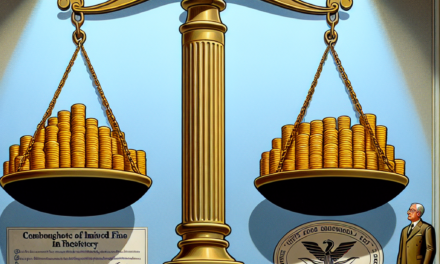“Prepare, Protect, Prosper: Smart Moves for the Bear Market Ahead.”
Introduction
A bear market, characterized by a prolonged decline in stock prices, is an inevitable phase in the economic cycle that every investor must anticipate. While the timing of such downturns is unpredictable, preparing for them is crucial to safeguarding and potentially enhancing one’s investment portfolio. As market volatility looms on the horizon, adopting strategic measures can mitigate risks and capitalize on opportunities. Here are three proactive investing moves I’m implementing to brace for the eventual arrival of a bear market: diversifying my portfolio to spread risk, increasing my cash reserves to seize buying opportunities, and focusing on high-quality, resilient stocks that can weather economic downturns. These steps aim to fortify my financial position and ensure long-term growth, regardless of market conditions.
Understanding Bear Markets: What History Teaches Us
Understanding bear markets is crucial for any investor aiming to navigate the complexities of the financial world. Historically, bear markets, defined as a decline of 20% or more in major stock indices, have been an inevitable part of the economic cycle. While they can be daunting, they also present unique opportunities for those who are well-prepared. By examining past bear markets, investors can glean valuable insights into how to strategically position their portfolios to weather the storm and potentially emerge stronger.
One of the first lessons history teaches us is that bear markets, though challenging, are temporary. Since the Great Depression, the stock market has experienced numerous downturns, each followed by a recovery. This cyclical nature underscores the importance of maintaining a long-term perspective. Investors who panic and sell off their assets during a downturn often miss out on the subsequent recovery. Therefore, adopting a patient and disciplined approach is essential. By focusing on long-term goals rather than short-term fluctuations, investors can better withstand the emotional rollercoaster that bear markets often bring.
In addition to maintaining a long-term outlook, diversification is another critical strategy that history advocates. During bear markets, not all asset classes perform equally. While equities may suffer, bonds and other fixed-income securities often provide a buffer against volatility. By diversifying across various asset classes, sectors, and geographies, investors can mitigate risk and reduce the impact of a downturn on their portfolios. This approach not only helps preserve capital but also positions investors to take advantage of different recovery trajectories across markets.
Moreover, bear markets offer a prime opportunity for value investing. As stock prices decline, fundamentally strong companies often become undervalued. Savvy investors can capitalize on these lower prices to acquire quality stocks at a discount. This strategy requires thorough research and analysis to identify companies with solid financials, competitive advantages, and growth potential. By focusing on intrinsic value rather than market sentiment, investors can make informed decisions that align with their long-term objectives.
Another historical insight is the importance of maintaining liquidity during bear markets. Having access to cash or cash-equivalents allows investors to seize opportunities as they arise. Whether it’s purchasing undervalued stocks or rebalancing a portfolio, liquidity provides the flexibility needed to act decisively. Furthermore, a cash reserve acts as a safety net, reducing the need to liquidate investments at a loss to cover unforeseen expenses.
Finally, it’s essential to remain informed and adaptable. Economic conditions and market dynamics are constantly evolving, and what worked in past bear markets may not necessarily apply in the future. By staying informed about economic indicators, policy changes, and global events, investors can make timely adjustments to their strategies. This proactive approach ensures that portfolios remain aligned with both current conditions and long-term goals.
In conclusion, while bear markets are an inevitable part of investing, they need not be feared. By learning from history, investors can implement strategies that not only protect their portfolios but also position them for future growth. Emphasizing a long-term perspective, diversification, value investing, liquidity, and adaptability can transform the challenges of a bear market into opportunities for success. As the adage goes, “The best time to plant a tree was 20 years ago. The second-best time is now.” Preparing for a bear market today can yield significant benefits in the years to come.
Diversification Strategies to Mitigate Bear Market Risks
In the ever-evolving landscape of financial markets, the inevitability of a bear market is a reality that every investor must confront. While the timing of such downturns is unpredictable, preparing for them is a prudent strategy. One of the most effective ways to mitigate the risks associated with a bear market is through diversification. By spreading investments across various asset classes, sectors, and geographical regions, investors can reduce the impact of market volatility on their portfolios. As I anticipate the eventual arrival of a bear market, I am implementing three key diversification strategies to safeguard my investments.
Firstly, I am focusing on asset class diversification. This involves allocating my investments across different types of assets, such as stocks, bonds, real estate, and commodities. Each asset class reacts differently to market conditions, and their performance is often uncorrelated. For instance, while stocks may decline during a bear market, bonds typically offer more stability and can even appreciate as investors seek safer havens. By maintaining a balanced mix of asset classes, I aim to cushion my portfolio against the full brunt of a market downturn. Moreover, including alternative investments like real estate and commodities can provide additional layers of protection, as these assets often have unique performance drivers that are not directly tied to the stock market.
In addition to asset class diversification, sector diversification is another critical component of my strategy. Within the stock portion of my portfolio, I am ensuring that my investments are spread across various sectors of the economy, such as technology, healthcare, consumer goods, and energy. Different sectors are affected by economic cycles in distinct ways. For example, while technology stocks might suffer during a downturn due to reduced consumer spending, healthcare stocks could remain resilient as demand for medical services persists regardless of economic conditions. By diversifying across sectors, I can reduce the risk of being overly exposed to any single industry that might be disproportionately impacted during a bear market.
Furthermore, geographical diversification is an essential aspect of my approach. By investing in international markets, I can tap into growth opportunities outside of my home country and reduce the risk associated with domestic economic downturns. Global diversification allows me to benefit from the economic cycles of different regions, which may not always align with those of my home market. For instance, while the U.S. economy might be experiencing a slowdown, emerging markets in Asia or Latin America could be on an upward trajectory. By holding a portion of my portfolio in international stocks and bonds, I can potentially offset losses in one region with gains in another.
In conclusion, while the timing of a bear market remains uncertain, the importance of being prepared cannot be overstated. Through asset class, sector, and geographical diversification, I am taking proactive steps to mitigate the risks associated with market downturns. These strategies not only help protect my portfolio from significant losses but also position me to capitalize on opportunities that may arise during periods of market volatility. By embracing diversification, I am building a resilient investment portfolio that can weather the inevitable challenges of a bear market, ensuring long-term financial stability and growth.
The Importance of Emergency Funds in a Bear Market
In the ever-fluctuating world of financial markets, the inevitability of a bear market is a reality that every investor must face. While the timing of such downturns is unpredictable, preparing for them is a prudent strategy. One of the most critical steps in safeguarding your financial well-being during a bear market is establishing a robust emergency fund. This financial cushion not only provides peace of mind but also ensures that you are not forced to liquidate investments at a loss during turbulent times.
An emergency fund serves as a financial safety net, designed to cover unforeseen expenses such as medical emergencies, car repairs, or sudden job loss. In the context of a bear market, having an emergency fund becomes even more crucial. During these periods, stock prices can plummet, and the economic environment can become uncertain, leading to potential job instability. By having a well-funded emergency reserve, you can avoid the need to sell off investments at depressed prices to cover your living expenses.
Moreover, an emergency fund allows you to maintain your investment strategy without interruption. In a bear market, the temptation to sell off assets to cover immediate financial needs can be strong. However, this often results in realizing losses and missing out on potential market recoveries. With a sufficient emergency fund, you can ride out the market downturn, giving your investments the opportunity to rebound when conditions improve. This long-term perspective is essential for achieving financial goals and building wealth over time.
Transitioning from the importance of maintaining your investment strategy, it is also vital to consider the size of your emergency fund. Financial experts typically recommend setting aside three to six months’ worth of living expenses. However, in anticipation of a bear market, it may be wise to aim for the higher end of this range or even extend it to cover up to a year’s worth of expenses. This extended buffer provides additional security and flexibility, allowing you to navigate prolonged economic downturns without financial strain.
Furthermore, the liquidity of your emergency fund is a key consideration. It should be easily accessible, stored in a savings account or money market fund, rather than tied up in investments that could lose value during a market decline. This ensures that you can quickly access the funds when needed, without incurring penalties or losses. Additionally, keeping your emergency fund separate from your investment accounts helps maintain a clear distinction between funds meant for immediate needs and those allocated for long-term growth.
In conclusion, while the timing of a bear market remains uncertain, the importance of preparing for it is undeniable. Establishing a well-funded and easily accessible emergency fund is a foundational step in safeguarding your financial future. It not only provides a buffer against unforeseen expenses but also allows you to maintain your investment strategy without interruption. By taking these proactive measures, you can navigate the challenges of a bear market with confidence, ensuring that your financial goals remain on track despite market volatility. As you prepare for the eventuality of a bear market, remember that a strong emergency fund is not just a safety net, but a strategic tool that empowers you to weather financial storms and emerge stronger on the other side.
Long-Term Investment Mindset: Staying the Course

In the ever-evolving landscape of financial markets, the inevitability of a bear market is a reality that every investor must confront. While the timing of such downturns remains uncertain, preparing for them is a prudent strategy that can safeguard one’s portfolio and ensure long-term financial stability. Embracing a long-term investment mindset is crucial in navigating these turbulent times, and there are several strategic moves that can be made to fortify one’s financial position.
First and foremost, diversification remains a cornerstone of any robust investment strategy. By spreading investments across a variety of asset classes, sectors, and geographic regions, investors can mitigate the risks associated with market volatility. This approach not only reduces the impact of a downturn in any single area but also positions the portfolio to benefit from growth in other sectors. For instance, while equities may suffer during a bear market, bonds or commodities might perform better, providing a buffer against losses. Therefore, regularly reviewing and adjusting the asset allocation to maintain a balanced and diversified portfolio is a critical step in preparing for a bear market.
In addition to diversification, maintaining a disciplined approach to investing is essential. This involves adhering to a well-defined investment plan and resisting the urge to make impulsive decisions based on short-term market fluctuations. Emotional reactions to market volatility can lead to costly mistakes, such as selling assets at a loss or deviating from one’s long-term strategy. By focusing on the bigger picture and remaining committed to the investment plan, investors can avoid the pitfalls of panic selling and instead capitalize on opportunities that arise during market downturns. This disciplined approach not only helps in weathering the storm but also positions the investor to take advantage of potential market recoveries.
Moreover, building a cash reserve is another strategic move that can provide flexibility and security during a bear market. Having a portion of the portfolio in cash or cash-equivalent assets allows investors to seize opportunities that may arise when asset prices are depressed. This liquidity can be used to purchase undervalued stocks or other assets at a discount, potentially leading to significant gains when the market rebounds. Additionally, a cash reserve can serve as a financial cushion, providing peace of mind and reducing the need to liquidate investments at an inopportune time to meet financial obligations.
Furthermore, it is important to continuously educate oneself about market trends and economic indicators. Staying informed about the broader economic environment can provide valuable insights into potential market movements and help investors make informed decisions. Engaging with financial news, attending seminars, and consulting with financial advisors are effective ways to enhance one’s understanding of the market dynamics. This knowledge not only aids in making strategic investment decisions but also reinforces confidence in the chosen investment strategy.
In conclusion, while the prospect of a bear market may seem daunting, adopting a long-term investment mindset and implementing strategic moves can significantly mitigate its impact. By diversifying the portfolio, maintaining discipline, building a cash reserve, and staying informed, investors can navigate the challenges of a bear market with resilience and poise. Ultimately, these strategies not only protect one’s financial interests but also lay the foundation for future growth and success in the ever-changing world of investing.
Identifying Defensive Stocks for Bear Market Protection
In the ever-evolving landscape of financial markets, the inevitability of a bear market is a reality that every investor must confront. While the timing of such downturns remains uncertain, preparing for them is a prudent strategy. One effective approach to safeguarding your portfolio is by identifying defensive stocks that can provide stability and protection during turbulent times. Defensive stocks, often characterized by their resilience in economic downturns, typically belong to sectors that provide essential goods and services. These include utilities, healthcare, and consumer staples, which tend to maintain steady demand regardless of economic conditions. By focusing on these sectors, investors can mitigate potential losses and preserve capital when the broader market experiences a decline.
To begin with, utility companies are a cornerstone of defensive investing. These firms provide essential services such as electricity, water, and natural gas, which remain in demand regardless of economic fluctuations. The consistent cash flow generated by utility companies often translates into reliable dividend payments, making them an attractive option for income-focused investors. Moreover, the regulated nature of the utility industry provides a level of predictability and stability that is particularly appealing during bear markets. As a result, incorporating utility stocks into a diversified portfolio can offer a buffer against market volatility.
In addition to utilities, the healthcare sector is another area where investors can find defensive opportunities. Healthcare companies, including pharmaceutical firms, medical device manufacturers, and healthcare service providers, benefit from the constant need for medical care and treatments. This sector’s resilience is underscored by the fact that people require healthcare services regardless of economic conditions. Furthermore, the aging global population and ongoing advancements in medical technology continue to drive demand for healthcare products and services. By investing in well-established healthcare companies with strong balance sheets and a history of innovation, investors can position themselves to weather market downturns while potentially benefiting from long-term growth.
Consumer staples represent another critical component of a defensive investment strategy. This sector includes companies that produce essential goods such as food, beverages, and household products. The demand for these items remains relatively stable even during economic slowdowns, as consumers prioritize basic needs over discretionary spending. Companies in this sector often possess strong brand recognition and pricing power, allowing them to maintain profitability in challenging economic environments. By selecting consumer staples stocks with a track record of consistent performance and dividend payments, investors can enhance their portfolio’s resilience against market declines.
While identifying defensive stocks is a crucial step in preparing for a bear market, it is equally important to maintain a diversified portfolio. Diversification helps spread risk across different asset classes and sectors, reducing the impact of any single investment’s poor performance. By combining defensive stocks with other asset classes such as bonds and alternative investments, investors can create a well-rounded portfolio that is better equipped to withstand market volatility.
In conclusion, the anticipation of a bear market necessitates a proactive approach to investing. By focusing on defensive stocks within the utilities, healthcare, and consumer staples sectors, investors can build a portfolio that offers protection and stability during economic downturns. Coupled with a diversified investment strategy, these defensive moves can help safeguard capital and provide peace of mind in the face of market uncertainty. As the financial landscape continues to evolve, being prepared for eventual downturns is not just wise but essential for long-term investment success.
The Role of Bonds in a Bear Market Portfolio
In the ever-evolving landscape of financial markets, the anticipation of a bear market is a reality that every investor must face. While the timing of such downturns is often unpredictable, preparing for them is a prudent strategy. One of the most effective ways to fortify a portfolio against the volatility of a bear market is through the strategic inclusion of bonds. Bonds, often considered the bedrock of conservative investing, play a crucial role in providing stability and income during turbulent times.
To begin with, bonds are essentially loans made by investors to borrowers, typically corporations or governments. In return for this loan, the borrower agrees to pay interest at regular intervals and to return the principal amount at maturity. This predictable income stream is one of the primary reasons bonds are favored during bear markets. Unlike stocks, which can experience significant price fluctuations, bonds tend to offer more stable returns. This stability can be particularly reassuring when equity markets are in turmoil.
Moreover, bonds often exhibit an inverse relationship with interest rates. When interest rates fall, bond prices typically rise, and vice versa. During a bear market, central banks may lower interest rates to stimulate economic activity, which can lead to an increase in bond prices. This potential for capital appreciation, coupled with regular interest payments, makes bonds an attractive option for investors seeking to preserve capital and generate income during market downturns.
In addition to their income-generating potential, bonds also serve as a diversification tool within a portfolio. Diversification is a fundamental principle of investing, aimed at reducing risk by spreading investments across various asset classes. By including bonds in a portfolio, investors can mitigate the impact of stock market volatility. This is because bonds and stocks often do not move in tandem; when stock prices fall, bond prices may remain stable or even increase, thereby cushioning the overall portfolio from severe losses.
Furthermore, the choice of bond type is critical in constructing a bear market portfolio. Government bonds, such as U.S. Treasuries, are generally considered the safest, as they are backed by the full faith and credit of the issuing government. These bonds are less likely to default and can provide a safe haven during economic uncertainty. On the other hand, corporate bonds, while offering higher yields, come with increased risk, particularly during economic downturns when companies may face financial difficulties. Therefore, a balanced approach, incorporating both government and high-quality corporate bonds, can enhance the resilience of a portfolio.
It is also worth noting that the duration of bonds plays a significant role in their performance during a bear market. Shorter-duration bonds are less sensitive to interest rate changes and can provide more stability, whereas longer-duration bonds may offer higher yields but come with increased interest rate risk. Thus, aligning bond duration with investment goals and risk tolerance is essential.
In conclusion, while no investment strategy can entirely eliminate the risks associated with a bear market, incorporating bonds into a portfolio can provide a measure of stability and income. By understanding the role of bonds and carefully selecting the appropriate types and durations, investors can better prepare for the eventuality of a bear market, ensuring that their portfolios remain resilient in the face of economic uncertainty.
How to Spot Early Warning Signs of a Bear Market
In the ever-evolving landscape of financial markets, the anticipation of a bear market is a concern that looms over investors. While the timing of such downturns is notoriously difficult to predict, being able to identify early warning signs can provide a strategic advantage. Understanding these indicators allows investors to make informed decisions and adjust their portfolios accordingly. One of the most telling signs of an impending bear market is a sustained decline in major stock indices. When indices such as the S&P 500 or the Dow Jones Industrial Average begin to show a consistent downward trend over several weeks or months, it may signal a shift in market sentiment. This decline often reflects broader economic concerns, such as slowing growth or geopolitical tensions, which can erode investor confidence.
In addition to stock indices, another critical indicator is the behavior of interest rates. Central banks, such as the Federal Reserve in the United States, play a pivotal role in setting monetary policy, which in turn influences interest rates. When central banks raise interest rates, borrowing costs increase, potentially slowing economic growth. A series of rate hikes can lead to reduced consumer spending and business investment, both of which are detrimental to corporate earnings and, by extension, stock prices. Therefore, monitoring central bank announcements and interest rate trends is essential for investors seeking to anticipate market downturns.
Moreover, the yield curve, which plots the interest rates of bonds with different maturities, is a valuable tool for spotting early warning signs of a bear market. An inverted yield curve, where short-term interest rates exceed long-term rates, has historically been a reliable predictor of recessions. This inversion suggests that investors expect slower economic growth in the future, prompting them to seek the safety of long-term bonds. As a result, an inverted yield curve can serve as a red flag for investors, indicating potential economic challenges ahead.
Corporate earnings reports also offer insights into the health of the market. When companies begin to report declining profits or issue negative guidance for future earnings, it may indicate underlying economic weaknesses. Investors should pay close attention to earnings season, as it provides a snapshot of how businesses are faring in the current economic environment. A trend of disappointing earnings across multiple sectors can foreshadow broader market declines.
Furthermore, geopolitical events and global economic conditions can act as catalysts for bear markets. Trade tensions, political instability, or economic slowdowns in major economies can have ripple effects across global markets. Investors should remain vigilant and consider the potential impact of such events on their portfolios. By staying informed about global developments, investors can better assess the risks and opportunities that may arise.
In conclusion, while predicting the exact timing of a bear market is challenging, being attuned to early warning signs can help investors prepare and protect their portfolios. By monitoring stock indices, interest rates, the yield curve, corporate earnings, and geopolitical events, investors can gain valuable insights into market trends. This proactive approach allows for strategic adjustments, such as diversifying investments or increasing cash reserves, to mitigate potential losses. Ultimately, staying informed and adaptable is key to navigating the uncertainties of financial markets and ensuring long-term investment success.
Q&A
1. **Question:** What is a bear market?
**Answer:** A bear market is a period during which stock prices fall by 20% or more from recent highs, often accompanied by widespread pessimism and negative investor sentiment.
2. **Question:** Why is it important to prepare for a bear market?
**Answer:** Preparing for a bear market is important because it helps investors protect their portfolios from significant losses and positions them to take advantage of potential opportunities when the market recovers.
3. **Question:** What is one investing move to make in preparation for a bear market?
**Answer:** One investing move is to diversify your portfolio across different asset classes, sectors, and geographic regions to reduce risk and increase resilience against market downturns.
4. **Question:** How can increasing cash reserves help during a bear market?
**Answer:** Increasing cash reserves provides liquidity and flexibility, allowing investors to buy undervalued stocks during a bear market or cover expenses without having to sell investments at a loss.
5. **Question:** What role does rebalancing play in preparing for a bear market?
**Answer:** Rebalancing involves adjusting the allocation of assets in a portfolio to maintain a desired risk level, ensuring that it remains aligned with long-term investment goals despite market fluctuations.
6. **Question:** Why might an investor consider focusing on high-quality stocks before a bear market?
**Answer:** High-quality stocks, typically characterized by strong financials, stable earnings, and solid management, are more likely to withstand economic downturns and recover more quickly when the market rebounds.
7. **Question:** How can maintaining a long-term perspective benefit investors during a bear market?
**Answer:** Maintaining a long-term perspective helps investors stay focused on their financial goals, avoid panic selling, and recognize that market downturns are a normal part of the investment cycle, often followed by periods of growth.
Conclusion
A bear market is an inevitable part of the economic cycle, and preparing for it is crucial for long-term investment success. To safeguard and potentially enhance my portfolio during such downturns, I am implementing three strategic moves. First, I am diversifying my investments across various asset classes to mitigate risk and reduce volatility. Second, I am increasing my allocation in defensive stocks and sectors that tend to perform better during economic slowdowns, such as utilities and consumer staples. Lastly, I am maintaining a cash reserve to take advantage of buying opportunities when asset prices are lower. By taking these proactive steps, I aim to protect my investments and position myself for future growth when the market eventually recovers.





